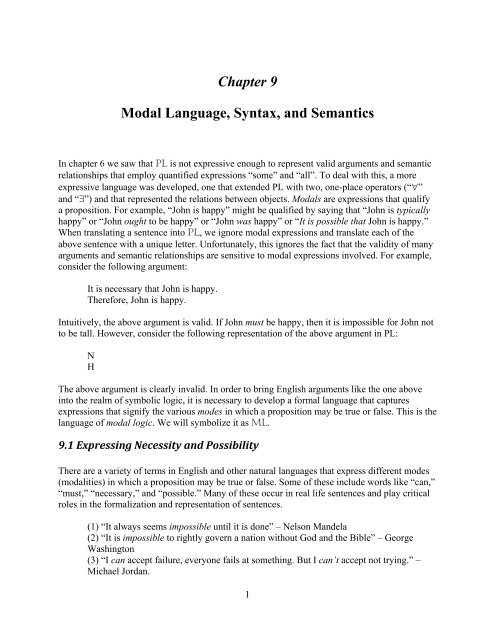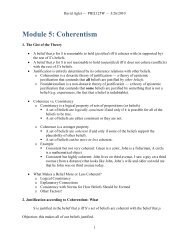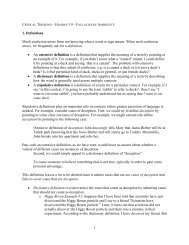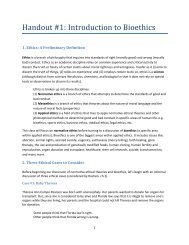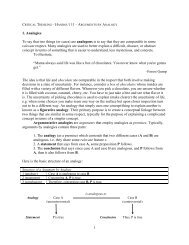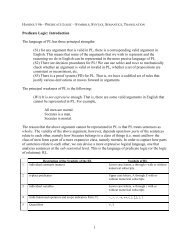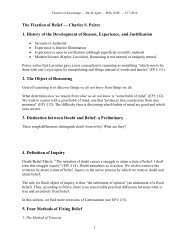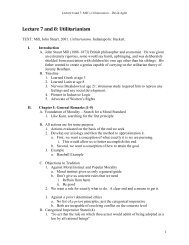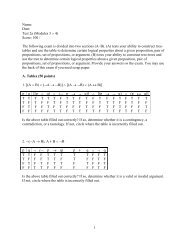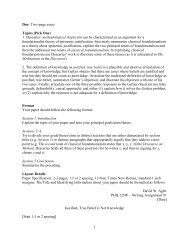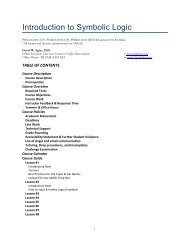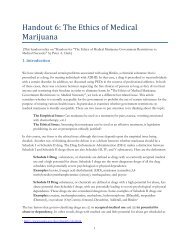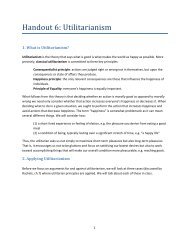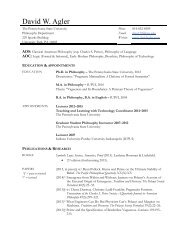Chapter 9 Modal Language, Syntax, and Semantics - David W. Agler
Chapter 9 Modal Language, Syntax, and Semantics - David W. Agler
Chapter 9 Modal Language, Syntax, and Semantics - David W. Agler
- No tags were found...
Create successful ePaper yourself
Turn your PDF publications into a flip-book with our unique Google optimized e-Paper software.
9.3 <strong>Language</strong> & <strong>Syntax</strong>The language <strong>and</strong> syntax of ML extends the language <strong>and</strong> syntax of PL. As such, ML retainsthe symbols used to represent propositions, truth-functional operators, <strong>and</strong> scope.1 Uppercase Roman (unbolded) letters (‘A1,’ ‘A2,’ ‘B,’ ‘C,’ …, ‘Z’) with or without subscriptedintegers for propositional letters2 Truth-functional operators (¬, ∧, ∨, →, ↔)3 Parentheses, braces, <strong>and</strong> brackets to indicate the scope of operatorsML extends PL with the following two one-place operators: ◊ (the diamond) <strong>and</strong> □ (the box).The syntax of ML allows for affixing the diamond “◊” to the left of a proposition P such that“◊P” is read as “It is possible that P” or “P is possible.” Similarly, the box “□” can be affixed tothe left of a proposition P such that “□P” is read as “It is necessary that P” or “P is necessary.”4 Two one-place modal operators (◊ <strong>and</strong> □)As with PL <strong>and</strong> RL, the syntax for ML can be formulated using a set of formation rules.Namely, a proposition in ML is a well-formed formula (wff) if <strong>and</strong> only if can be formulated bythe following set of rules:(1) Single propositional letters A, B, C, ..., Z with <strong>and</strong> without numerical subscripts arewffs.(2) If P is a wff, then so is ¬(P).(3) If P <strong>and</strong> R are wffs, then so are P∧R, P∨R, P→R, P↔R.(4) If P is a wff, then so is ◊(P) <strong>and</strong> □(P).(5) Nothing else is a wff except in virtue of (1)–(5).Similar to the syntax of PL <strong>and</strong> RL, two conventions are adopted for the scope of 1-placeoperators. Convention #1 is that parentheses are optional when a 1-place operator operates upona single propositional letter or another 1-place operator. Thus, ¬(P), ◊(P), ◊(□(P)) can besimplified to ¬P, ◊P, <strong>and</strong> ◊□P, respectively when “P” is a single propositional letter. Convention#2 involves the use of braces [ ] <strong>and</strong> brackets { } when a set of parentheses is contained inanother set of parentheses. Thus, P∨(S∨(M∨(L∧T))) is more perspicuously symbolized asP∨{S∨[M∨(L∧T)]}.As in PL, formation rules are used recursively to create any wff in ML. To illustrate,consider the following:Show that □◊P is a wff.1 P is a wff Rule 12 If P is a wff, then ◊P is a wff. Rule 4 + Line 13 If ◊P is a wff, then □◊P is a wff Rule 4 + Line 24
The use of the formation rules for ML begin with identifying the needed propositional letters,proceed to attaching those operators having the least scope, until the operator with the mostscope is attached. As a final example, consider a more complicated use of the formation rules:Show that ¬(□◊P→□R) is a wff.1 P <strong>and</strong> R are wffs Rule 12 If R is a wff, then □R is a wff. Rule 4 + Line 13 If P is a wff, then ◊P is a wff. Rule 4 + Line 24 If ◊P is a wff, then □◊P is a wff. Rule 4 + Line 35 If □◊P <strong>and</strong> □R are wffs, then □◊P→□R is a wff. Rule 3 + Line 2, 46 If □◊P→□R is a wff, then ¬(□◊P→□R) is a wff. Rule 2 + line 5Exercise Set #1A. <strong>Syntax</strong>: Identifying well-formed formulas. State whether the following are well-formedformulas in ML.1. ◊P2. □¬P3. ¬□(P→R)4. □□(P→R)5. □P→R6. P□∧P7. P□→P◊8. ¬◊¬P9. ◊(□P)10. ¬P□¬PB. <strong>Syntax</strong>: Using the formation rules. Using the formation rules provided in this chapter, showthat the following formulas are wffs.1. ◊P2. □P3. ¬□P4. □(P→R)5. □¬(P→R)6. ◊□P7. □◊P8. □(◊P↔R)9. ◊□P∧¬□◊P10. (□P→□□P)→(□□P→□P)9.4* Types of Relations: Preparation for 9.5Intuitively, a relation is some way in which two or more objects are connected or taken together.For example, if John is taller than Liz, we say that one way that John <strong>and</strong> Liz can be takentogether is through the taller-than relation. The st<strong>and</strong>ing-between relation is another example. If5
John is st<strong>and</strong>ing between Liz <strong>and</strong> Sam, we say that that st<strong>and</strong>ing-between is a way in which threeobjects (John, Liz, <strong>and</strong> Sam) can be connected.Relations specify the number of objects that they connect or take together. The taller-thanrelation is a binary (2-place) relation as it connects two objects. The st<strong>and</strong>ing-between relation isa tertiary (3-place) relation as it connects three objects. While common relations are unary (1-place), binary (2-place), tertiary (3-place), a relation can connect any number of objects. To keepopen the possibility of talking about relations that connect four, five, or more objects, any givenrelation is an n-place relation, where ‘n’ is a placeholder for the number of objects it connects.But what is a relation? A relation is just a set of n-tuples, an n-tuple being an ordered listof elements. The tall relation is the 1-place relation that is just the set of tall objects. The tallerthanrelation is a 2-place relation <strong>and</strong> so it is a set whose members consist of ordered pairs where the first element x is taller than the second element y. The st<strong>and</strong>ing-between relation is the3-place relation consisting of triples where x is st<strong>and</strong>ing between y <strong>and</strong> z. And, finally,an n-place relation is a set of n-tuples.RelationAn n-place relation is a set of n-tuples.When an n-tuple like is a member of a relation R, we say that a <strong>and</strong> b “st<strong>and</strong> in” R (i.e.,st<strong>and</strong> in relation R). Thus, if John is taller than Liz, we can say that John <strong>and</strong> Liz “st<strong>and</strong> in” thetaller-than relation. To abbreviateThere are several important binary (2-place) relations worth mentioning:R is serial in A iff for every x∈A there is some y in A such that RxyR is reflexive in A iff for every x∈A, RxxR is irreflexive in A iff for every x∈A, it is not the case that RxxR is symmetric in A iff for every x <strong>and</strong> y ∈A, if Rxy, then RyxR is asymmetric in A iff for every x <strong>and</strong> y ∈A, if Rxy, then not RyxR is transitive in A iff for every x, y, <strong>and</strong> z ∈A if Rxy <strong>and</strong> Ryz, then RxzR is an equivalence relation in A iff R is symmetric, transitive, <strong>and</strong> reflexive in A.R is total in A iff for every x <strong>and</strong> y ∈A, RxyThe equal-to relation is reflexive for the set of positive integers {1, 2, 3, …} since for everyinteger x in {1, 2, 3, …}, x is equal to x. In contrast, the taller-than relation is an irreflexiverelation as no object is taller than itself. Further, the being married relation is a symmetricrelation for if John is married to Liz, then Liz is also married to John.There are three additional points worth considering about relations. First, a relation canbe more than one type of relation. One example are asymmetric relations, which are irreflexive.To consider a second example, let’s reflect on the greater-than-or-equal-to relation (we’llabbreviate this as “R”) for the set of positive integers {1, 2, 3, …}. This relation is the set ofordered pairs where x is greater than y:{, , , , , , , …}6
Notice that this relation is serial since for every integer x, there is always some number y where xis greater than y. It is also reflexive since as integer x is greater than or equal to itself. However,it is not symmetric as 5 is greater than or equal to 4, but 4 is not greater than or equal to 5.Second, some relations only apply to specific sets. The sister-of relation is asymmetricfor the set of all people but it is not for a set whose members consist of a group of sisters. If wehave a set consisting of Liz <strong>and</strong> John, Liz may be the sister of John but John is not the sister ofLiz. R is asymmetric in this set. In contrast, in a set that consists of Liz <strong>and</strong> Sam, where both aresisters of each other, the sister-of relation is symmetric rather than asymmetric since Liz is asister of Sam <strong>and</strong> Sam is a sister of Liz.Third, it is important to keep in mind that the above relations are defined using variablesx <strong>and</strong> y of a set A. Although the variables are notationally distinct—i.e., the variable x is not thevariable y—x <strong>and</strong> y can have the same value. As an illustration, consider whether x loves yrelation is a total relation for a set where everyone loves everyone except themselves. For thisset, it is true that if we substitute a member for x <strong>and</strong> a distinct member for y, then for every x<strong>and</strong> y in the set, x loves y. But x <strong>and</strong> y range over the entire set <strong>and</strong> so they could choose the samemember. In that case, x loves y would not be a total relation.Exercise Set #2A. Examples of Binary Relations: Come up with an example of the following binary relations (besure to indicate the set that the relation applies to)1. Serial2. Equivalence3. Total4. Irreflexive5. ReflexiveB. Binary Relations: Consider the following examples of binary relations. Identify what kind ofbinary relation these relations instantiate (at least one) <strong>and</strong> explain why, e.g. “greater than is atransitive relation for the positive integers since for any positive number x, y, <strong>and</strong> z, if x is greaterthan y, <strong>and</strong> y is greater than z, then x is greater than z.”1. Holding h<strong>and</strong>s, as in x holds y’s h<strong>and</strong>2. Less than, as in x is numerically less than y.3. Loving, as in x loves y4. Father of, as in x is the father of y.5. Boss of, as in x is the boss of y.9.5 <strong>Modal</strong> Logic <strong>Semantics</strong>The approach to ML semantics considered here is known as possible-worlds semantics. Thisapproach is based on the idea that a proposition P is necessarily true if <strong>and</strong> only if it is true in allpossible worlds <strong>and</strong> P is possibly true if <strong>and</strong> only if it is true in at least one possible world.Propositions will not be assigned truth values absolutely but always relative to possible worlds.Thus, the truth value of formulas like P, ¬P, P∧R, □P are always determined relative to a givenpossible world. The truth values of propositions without modal operators (e.g., P∧R) will bedetermined within a single world w 1 using truth-table definitions for operators, e.g. P∧R is true in7
To clarify (6): ‘It is possibly the case that P’ is true at a world w just in the case that P is true atsome world u that is accessible to w. To clarify (7): ‘It is necessarily the case that P’ is true at aworld w just in the case that P is true at every world u that w accesses.Using the valuation function described above, it is possible to determine the truth valuesgiven a description of a model. For example, let’s consider the following model M:M =, whereW ={w 1 , w 2 },R ={, }, <strong>and</strong>I(P, w 1 )=F, I(P, w 2 )=F, I(S, w 1 )=T, I(S, w 2 )=TThe frame of this model consists of two possible worlds w 1 <strong>and</strong> w 2 , where each of these worldsaccesses the other but neither accesses itself. There are two propositional letters for which theinterpretation function assigns truth values relative to the two worlds. Using this model <strong>and</strong> thevaluation function specified above, we can determine the truth values of any wff relative to itsworld. For wffs without any modal operators, the procedure is straightforward: for a given world,use the interpretation of propositional letters along with the truth-functional definitions for theoperators to determine the truth value of the wff.To illustrate, let’s consider v M (P∧S, w 1 ):Determine the truth value of v M (P∧S, w 1 )1 v M (P, w 1 )=F since I(P, w 1 )=F Rule 12 v M (S, w 1 )=T since I(S, w 1 )=T Rule 13 v M (P∧S, w 1 )=F since v M (P, w 1 )=F <strong>and</strong> v M (S, w 1 )=T 1, 2 + Rule 2Notice that in the above example, it is only necessary to consider the truth values of “S” <strong>and</strong> “P”at w 1 . The case, however, is different when it comes to wffs with modal operators. In these cases,we valuate a proposition P relative to a world w, it is necessary to consider the worlds that waccesses. To illustrate, let’s consider v M (□S, w 1 ):Determine the truth value of v M (□S, w 1 )1 v M (S, w 2 )=T since I(S, w 2 )=T Rule 12 v M (□S, w 1 )=T since Rw 1 w 2 <strong>and</strong> v M (S, w 2 )=T 1, Rule 7Since “□S” is true at w 1 if <strong>and</strong> only if “S” is true at every world that w 1 accesses, w 1 accesses w 2<strong>and</strong> no other world (even itself), the truth value of “□S” at w 1 depends upon the truth value of“S” at w 2 <strong>and</strong> no other world.Note: Add discussion of Duality & Diagrammic Representation of Interpretation (see Non-Classical Logics)Exercise Set #39
A. Valuating wffs at a world in a Model: Consider the following model <strong>and</strong> determine whether ornot the following propositions are true or false:M = whereW ={w 1 , w 2 },R ={, }, <strong>and</strong>I(P, w 1 )=T, I(P, w 2 )=F, I(S, w 1 )=T, I(S, w 2 )=T1. v M (¬P, w 1 )2. v M (P∧S, w 2 )3. v M (P→S, w 1 )4. v M (◊P, w 1 )5. v M (◊P, w 2 )6. v M (□S, w 1 )7. v M (□S, w 2 )8. v M (◊¬P, w 1 )9. v M (¬□P, w 1 )10. v M (◊□P, w 1 )B. Testing Your Underst<strong>and</strong>ing: Using the above model, what additional information is neededto determine the truth value of the following proposition: ◊¬P. What does this say about modallogic semantics <strong>and</strong> the nature of possibility <strong>and</strong> necessity?10
9.5 <strong>Modal</strong> Systems: S, D, T, B, S4, S5In the previous section, a generic definition of a model was provided along with a description ofhow to assign truth values to wffs given a fleshed-out model. In this section, we consider thesemantics for various modal systems. There are several obstacles for constructing a semantics forML. First, as the modal operators ◊ <strong>and</strong> □ are not truth-functional, it is not possible to representthe semantics of ML using truth tables or truth-tree diagrams. Recall that a propositionaloperator is truth-functional if <strong>and</strong> only if the truth value of the complex proposition P, composedof propositions R <strong>and</strong> S, is determined entirely by the truth values of R <strong>and</strong> S. That is, since thepropositional operator “∧” is truth-functional, we can determine the truth-value of “A∧B” giventhe truth values of “A” <strong>and</strong> “B”. In contrast, “possibly” <strong>and</strong> “necessarily” (<strong>and</strong> theircorresponding operators) are not truth-functional. That is, the truth values of “possibly P” <strong>and</strong>“necessarily P” are not determined by the truth value of P. If “possibly’ <strong>and</strong> “necessarily” weretruth-functional, then it would be possible to determine the truth value of sentences like “It ispossible that John is planning a picnic” from the truth value of “John is planning a picnic.”Unfortunately, this cannot be determined for if we suppose that John is not planning a picnic, thetruth or falsity of “It is possible that John is planning a picnic” will depend upon additionalfactors we don’t have access to: is John even alive to do the planning? is John capable ofplanning a picnic?The second obstacle is more problematic, philosophical, <strong>and</strong> irksome. In propositional<strong>and</strong> predicate logic, barring a few isolated cases, there is a strong consensus about the formulathat should count as tautologies in PL <strong>and</strong> RL. Proposition of the form “P∨¬P”, “P→P”,“P→(Q→P)” are true independent of the specific propositions we substitute for “P” <strong>and</strong> “Q”.For a language involving ◊P <strong>and</strong> □P, what propositions should count as tautologies <strong>and</strong> whatarguments should count as valid? While there are some formula that clearly should count astautologies, e.g. □(P∨¬P) <strong>and</strong> ¬◊(P∧¬P), there are several formula where it is uncertainwhether they should count as tautologies, e.g., ◊□P→P.Rather than solving this philosophical problem, we sidestep it by developing a variety ofdifferent modal systems. These systems are named K, D, T, B, S4, <strong>and</strong> S5. While each modalsystem shares a common set of symbols <strong>and</strong> syntax, <strong>and</strong> uses the generic notion of a model, eachof these systems is distinguished by their semantics. Specifically, K, D, T, B, S4, <strong>and</strong> S5 aredistinguished according to what formal properties belong to the accessibility relation R. Theseformal properties (<strong>and</strong> their corresponding systems) are as follows:<strong>Modal</strong> SystemKDTBS4S5Property of Accessibility RelationNoneSerialReflexiveReflexive <strong>and</strong> SymmetricReflexive <strong>and</strong> TransitiveReflexive, Symmetric, <strong>and</strong> TransitiveThus, in system S4 (i.e., in a S4-model), the accessibility relation R is both reflexive <strong>and</strong>transitive. That is, for any set of worlds W in a S4-model, every member of W accesses itself <strong>and</strong>11
for every world in W, if w′ accesses w′′ <strong>and</strong> w′′ accesses w′′′, then w′ accesses w′′′. In contrast, in aD model, the accessibility relation R is serial such that for every world w′∈ W, there is somew′′∈W such that Rw′w′′.The different formal properties which characterize the accessibility relation have aneffect on which well-formed formula will count as tautologies, contradictions, contingencies,which arguments will count as valid, <strong>and</strong> which formula count as being a semantic consequencefrom a set of formula. That is, in some modal systems, a given argument will count as valid,while in others, it will not.ValidSemanticConsequenceAn argument ⊨ P is valid in a ML-model (M =) iff for every w∈W,v M (P, w)=TA wff R is a semantic consequence of a set of propositions {P} in an MLmodel(M =) iff for every w∈W, if v M (S, w)=T for each S∈{P}, thenv M (R, w)=T.• Illustration of How Some arguments are invalid & Counter-models• Illustrations of How Some Arguments are valid in S5 but not in K• Translations• Metaphysical Issues.Exercise Set #412
Exercise Set #2A. <strong>Semantics</strong>1.2.3.4.5.6.7.8.9.10.B. Models1.2.3.4.5.6.7.8.9.10.9.4.2 Normal <strong>Modal</strong> Logic <strong>Semantics</strong>K <strong>and</strong> its restrictionsfor Extensions of K8.Exercise Set #3A. <strong>Semantics</strong>1.2.3.4.5.6.13
7.8.9.10.9.5 <strong>Modal</strong> Logic TranslationWith the symbols, syntax, <strong>and</strong> semantics of ML articulated, ML allows for the symbolization ofa number of propositions previously impossible with PL. For example, consider the argument putforward at the beginning of this chapter:It is necessary that John is happy.Therefore, John is happy.The language of ML, now makes it possible to translate this argument as follows:□J ⊢ JIn addition to the above translations, the language of ML makes possible a number oftranslations that were previously impossible in PL:English SentenceIt is possible that John is a zombie.It is necessarily the case that Frank is a vampire.It is possible that both John is a zombie <strong>and</strong> Mary is not a mutant.It is not necessarily the case that Frank is a not a vampire or Mary is not amutant.Translation into ML◊J□F◊ (J∧¬M)¬□(¬F∨¬M)In many cases, translating an English sentence involving the wff in ML can be done in astraightforward manner, assigning upper-case letters to simple sentences, assigning truthfunctionaloperators like “¬” <strong>and</strong> “∧” to propositional operators like “not” <strong>and</strong> “<strong>and</strong>,” <strong>and</strong> thenthe modal operators “◊” <strong>and</strong> “□” to modal terms like terms like “can” <strong>and</strong> “must.” Let’s call anytranslation of this type, a surface translation.Fortunately or unfortunately, not every English sentence can be given a surfacetranslation. For consider the following sentence(1) If Vic is a bachelor, then he must not be married.If we represent ‘Vic is a bachelor’ as ‘B’ <strong>and</strong> ‘John is not married’ as ‘¬M’, a si(2) B→□¬M14
However, if the above conditional is true <strong>and</strong> also that Vic is a bachelor is true, then it wouldfollow that it is necessarily the case that John is unmarried. The problem, however, is that it ispossible for the(3) □(B→¬M)The language of ML is capable of disambiguating several differentExercise Set #4A. Translation: Translate the following wffs from ML into English sentences.1. It is possible that John is not happy.2. It is necessary that Liz plays guitar.3. If John isn’t happy, then he should stop drinking.4. It is possible that Liz will go to the party <strong>and</strong> it is possible that she won’t.5. John may or may not get the job.6. It is not possible for Barack Obama to win a third term.7.8.9.10.B. Translation: Translate the following wffs English sentences into wffs in ML.1.2.3.4.5.6.7.8.9.10.15
9.6 What are possible worlds?The semantics of modal logic may strike you as a useful way of representing the truth <strong>and</strong> falsityof propositions that involve modal terms, but the notion of a possible world raises severalquestions about the status of possible worlds <strong>and</strong> perhaps even cast some doubt on the nature ofmodal logic as a whole. Do possible worlds really exist? If they do, in what sense do they exist?If they don’t, what does this mean for modal logic? How do possible worlds relate to the actualworld?9.6.1 <strong>Modal</strong> Realism: Possible worlds exist as concrete objects9.6.2 <strong>Modal</strong> Actualism: Possible worlds are abstract entities, they don’t really exist9.6.3 Meinongianism: Possible worlds are non-existent objectsExercise Set #51.2.3.4.5.6.7.8.9.10.16
<strong>Chapter</strong> 10<strong>Modal</strong> Logic TreesIn chapters 4 <strong>and</strong> 7, truth trees were used to represent various semantic properties ofpropositions, sets of propositions, <strong>and</strong> arguments. Truth trees, much like truth-tables, are aneffective decision procedure for propositional logic <strong>and</strong> a partial-decision procedure for predicatelogic. In this chapter, the truth-tree method is formulated for modal logic.but it will also allow for us to test propositions, sets of propositions, <strong>and</strong> arguments for variouslogical properties (consistency, contingency, validity, etc.).10.1. <strong>Modal</strong> Logic Tree Setup <strong>and</strong> RepresentationPropositional modal logic trees (hereafter modal trees) are setup in the same way that truth treesare in propositional logic. In terms of decomposition, as ML is an extension of PL, propositionalmodal logic trees extend the truth-tree method from propositional logic. Thus, many propositionswill be decomposed using the propositional logic decomposition rules. For example, “P∧R” willbe decomposed using ∧D.However, one difference between the propositional <strong>and</strong> modal trees is that the truth ofevery proposition in a modal tree is relative to a world. In order to indicate this, we write w witha subscripted integer so as to specify which world that particular proposition is being evaluatedat.<strong>Modal</strong> Logic Tree1 ¬[P→¬(P∨Q)], w 0 P2 ¬P, w 0 1 ¬→D3 ¬(P∨Q), w 0 1 ¬→D4 ¬P, w 0 3 ¬∨D5 ¬Q, w 0 3 ¬∨DHowever, to simplify, we will abbreviate our notation by using positive integers <strong>and</strong> droppingthe use of w at each line. Thus, the modal tree above can be simplified as follows:1 ¬[P→¬(P∨Q)], 0 P2 ¬P, 0 1 ¬→D3 ¬(P∨Q), 0 1 ¬→D17
There are four quantifier rules4 ¬P, 0 3 ¬∨D5 ¬Q, 0 3 ¬∨D10.2. Negated Box <strong>and</strong> Diamond DecompositionThe first two modal tree decomposition rules concern propositions where a negation operatesupon a modal operator.Negated Diamond Decomposition (¬◊D)¬◊P, i □¬P, iNegated Box Decomposition (¬□D)¬□P, i ◊¬P, iNegated diamond decomposition <strong>and</strong> negated box decomposition.1 ¬◊(P∧R), 0 P2 ¬□(P→R), 1 P3 □¬(P∧R), 0 1¬◊D4 ◊¬(P→R), 1 2¬□D10.3. Box <strong>and</strong> Diamond DecompositionThe second two modal tree decomposition rules concern propositions where the main operator isa modal operator.Diamond Decomposition (◊D)◊P, I iR jP, jwhere j is a world that does not previouslyoccur in the branchBox Decomposition (□D)□P, iiR j~P, jwhere w i Rw j occurs somewhere in the branchIn the case of diamond decompositionIn the case of box decomposition18
10.4 Analysis with <strong>Modal</strong> Logic TreesAt the beginning of the chapter 9, it was noted that the following argument is valid but that therewas no way to express this validity in the less expressive PL:ItIt is necessary that John is happy.Therefore, John is happy.19
<strong>Chapter</strong> 11<strong>Modal</strong> Logic Derivations20


